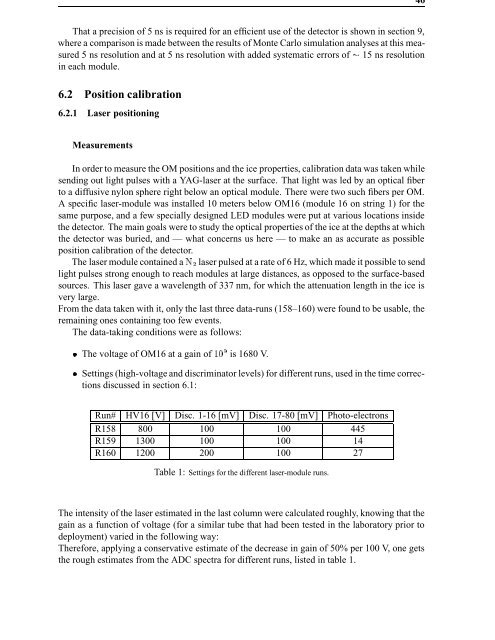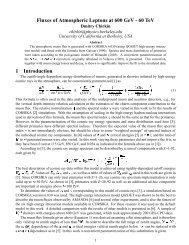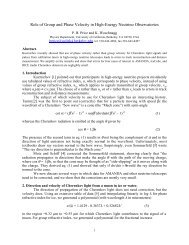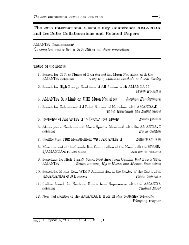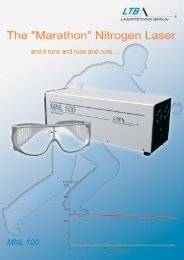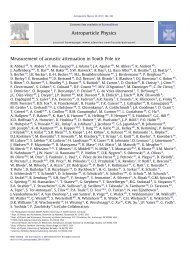Link to Fulltext
Link to Fulltext
Link to Fulltext
Create successful ePaper yourself
Turn your PDF publications into a flip-book with our unique Google optimized e-Paper software.
That a precision of 5 ns is required for an efficient use of the detec<strong>to</strong>r is shown in section 9,<br />
where a comparison is made between the results of Monte Carlo simulation analyses at this measured<br />
5 ns resolution and at 5 ns resolution with added systematic errors of ¥ 15 ns resolution<br />
in each module.<br />
6.2 Position calibration<br />
6.2.1 Laser positioning<br />
Measurements<br />
In order <strong>to</strong> measure the OM positions and the ice properties, calibration data was taken while<br />
sending out light pulses with a YAG-laser at the surface. That light was led by an optical fiber<br />
<strong>to</strong> a diffusive nylon sphere right below an optical module. There were two such fibers per OM.<br />
A specific laser-module was installed 10 meters below OM16 (module 16 on string 1) for the<br />
same purpose, and a few specially designed LED modules were put at various locations inside<br />
the detec<strong>to</strong>r. The main goals were <strong>to</strong> study the optical properties of the ice at the depths at which<br />
the detec<strong>to</strong>r was buried, and — what concerns us here — <strong>to</strong> make an as accurate as possible<br />
position calibration of the detec<strong>to</strong>r.<br />
The laser module contained a¤ laser pulsed at a rate of 6 Hz, which made it possible <strong>to</strong> send<br />
light pulses strong enough <strong>to</strong> reach modules at large distances, as opposed <strong>to</strong> the surface-based<br />
sources. This laser gave a wavelength of 337 nm, for which the attenuation length in the ice is<br />
very large.<br />
From the data taken with it, only the last three data-runs (158–160) were found <strong>to</strong> be usable, the<br />
remaining ones containing <strong>to</strong>o few events.<br />
The data-taking conditions were as follows:<br />
The voltage of OM16 at a gain of ¡ § is 1680 V.<br />
Settings (high-voltage and discrimina<strong>to</strong>r levels) for different runs, used in the time corrections<br />
discussed in section 6.1:<br />
Run# HV16 [V] Disc. 1-16 [mV] Disc. 17-80 [mV] Pho<strong>to</strong>-electrons<br />
R158 800 100 100 445<br />
R159 1300 100 100 14<br />
R160 1200 200 100 27<br />
Table 1: Settings for the different laser-module runs.<br />
The intensity of the laser estimated in the last column were calculated roughly, knowing that the<br />
gain as a function of voltage (for a similar tube that had been tested in the labora<strong>to</strong>ry prior <strong>to</strong><br />
deployment) varied in the following way:<br />
Therefore, applying a conservative estimate of the decrease in gain of 50% per 100 V, one gets<br />
the rough estimates from the ADC spectra for different runs, listed in table 1.<br />
46


